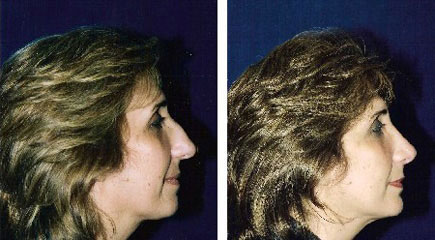 Sure, all noses are unique but depending on your ethnicity, you may share some unique nasal characteristics, depending on your family background.Worldwide, cosmetic plastic surgeons performed nose reshaping on 730,00 patents, according to the International Society of Aesthetic Plastic Surgery (ISAPS).
Sure, all noses are unique but depending on your ethnicity, you may share some unique nasal characteristics, depending on your family background.Worldwide, cosmetic plastic surgeons performed nose reshaping on 730,00 patents, according to the International Society of Aesthetic Plastic Surgery (ISAPS).
ISAPS also explains the most common concerns for which patients seek rhinoplasty: a too wide or flat nose bridge, a large, bulbous tip, an overly long or big nose, a pointy or crooked nose and a large nasal hump.
(See some before & after nose job pictures.)
It’s not a case of having a pretty nose. Rather, a misshapen nose draws negative attention and does not match the person’s face or profile as in the left picture above of an Iranian woman who had Middle Eastern rhinoplasty. (Photos: Robert Kotker, MD, FACS.)
Here are the frequent nasal features and shapes various ethnicities find unattractive:
Asians: A low, flat nasal bridge:
- Round, often flat tip
- Thicker skin (very important in rhinoplasty.)
- A low, flat nasal bridge
- Wide nostrils with thick outer walls
- Softer, weaker nasal cartilage (also important in rhinoplasty.)
Hispanic noses differ by ancestry. Those who came from a mostly Spanish line tend to have lighter, thinner skin, stronger cartilage and other characteristics of Northern European noses.
Hispanics descended from Central or South American Indians tend to show:
- A high bridge with a prominent nasal bump
- Thicker skin
- Wide, oblong nostrils with thick outer walls
- A wide, plunging flat nose tip
- Short upper lip
- Softer cartilage
Middle Eastern (or Mediterranean:)
These noses are often longer, but droop a little so that smiling can mean the tip of the nose bends farther, almost touching the lips in some cases. For people in this part of the world, the nasal tip is often bulbous, requiring surgical narrowing along with often flared nostrils.
Other noses have a prominent hump which the rhinoplasty surgeon must carefully file down. Many others also require the nasal bridge to be reduced.
(See the revision rhinoplasty & before & after photos.)
African-American Noses:
These noses sometimes have features comparable to Asian or Hispanic noses. Nasal features that contrasts most with Caucasian noses are:
- Low flat bridge.
- Wide nostrils with thick walls.
- Disproportional width compared to length.
For Asian, Hispanic and African-American noses, the surgeon must frequently raise the bridge and strengthen the nasal tip.
African-Americans frequently ask for the nostrils to be narrowed. That requires artfully placed incisions next to the nose, hidden in the crease between the nostril wall and the cheek. When healed that incision is nearly invisible.
For a change of pace, – but equally effective — read about the the permanent, non-surgical rhinoplasty.

